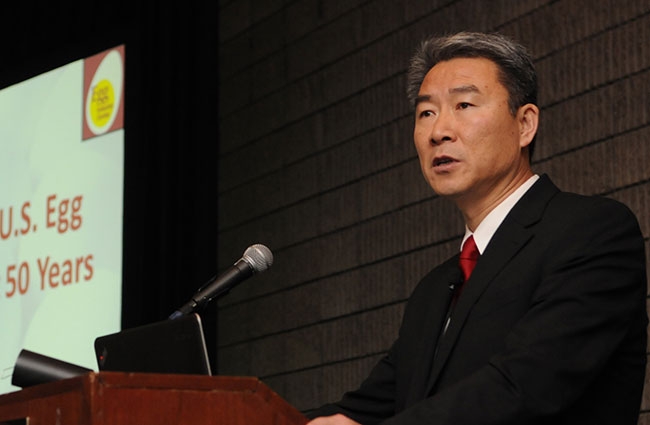
Sustainability is Good for Business
By US POULTRY
Features Business & Policy Emerging Trends agricultural industries must learn to communicate more specifically and unambiguously with stakeholders and others about their sustainability programs at the Animal Agriculture Sustainability Summit held during the 2015 International Production & Processing Expo. Business/Policy customers Executive Director Global observed Dr. Marty Matlock University of Arkansas Office for Sustainability With significant increases in food production needed over the next few decades to support the growing populationIt’s also about continuous improvement
 Dr. Hongwei Xin, director of the Egg Industry Center at Iowa State University, says U.S. egg production advanced dramatically between 1960 and 2010 while the environmental footprint declined
Dr. Hongwei Xin, director of the Egg Industry Center at Iowa State University, says U.S. egg production advanced dramatically between 1960 and 2010 while the environmental footprint declined
With significant increases in food production needed over the next few decades to support the growing population, agricultural industries must learn to communicate more specifically and unambiguously with stakeholders, customers, and others about their sustainability programs, observed Dr. Marty Matlock, executive director, University of Arkansas Office for Sustainability, at the Animal Agriculture Sustainability Summit held during the 2015 International Production & Processing Expo.
“When we talk in big, glib, hand waving ways, it does not help us to communicate to our constituents what we are doing. When people ask what sustainability is, I want you to say that sustainability is good for business. It increases efficiency, and it drives down negative things. The second thing you need to say is that sustainability is about continuous improvement,” Dr. Matlock said. He emphasized that continuous improvement means defining and identifying key performance indicators, measuring and benchmarking them, and implementing goals and strategies to achieve them.
Elaborating on the benchmarking aspect of sustainability initiatives, Dr. Greg Thoma, Ralph E. Martin professor of Chemical Engineering at the University of Arkansas, reviewed case studies remarking that sustainability initiatives often rely heavily on life cycle assessment (LCA). A LCA is a technique to assess the environmental aspects and potential impacts associated with a product, process or service and are used to quantify inputs and outputs in terms of a standardized unit of measure. Important characteristics of a LCA include that it be grounded in scientific methodologies, the data should be transparent, validated, widely available and inexpensive, and the same data and models should be used by producers, retailers, policymakers, nongovernmental organizations and consumers. “The process of developing and working with a LCA should be largely by consensus, and the guidelines should be pragmatic,” Dr. Thoma said.
Results of a 50-year review of the U.S. egg industry indicate production advanced dramatically between 1960 and 2010 while the environmental footprint declined, according to Dr. Hongwei Xin, director of the Egg Industry Center at Iowa State University, Ames, Iowa. Dr. Xin is also a distinguished professor and chair for research in the Agricultural and Biosystems Engineering Department.
The work was published in the February 2014 issue of Poultry Science. The objectives were to quantify what in production has changed over 50 years, characterize the supply chain footprint and identify hot spots for further improvement. The data obtained from sources, such as books and publications from 50 years ago and an elaborate survey system for 2010 data, yielded data on 57.1 million pullets and 92.5 million laying hens, representing about one-third of the total national inventory in each industry. The research found that comparing production performance levels to 1960 birds, 2010 hens have 26 per cent lower feed intake, 26 per cent lower feed intake, 27 per cent higher egg production rate, 42 per cent better feed conversion, 57 per cent lower mortality and 32 per cent lower water use.
A poultry industry sustainability program is in its early stages following two meetings last fall and formation of a workgroup of representatives from the broiler and turkey industries tasked with defining the mission and goals of the program and subsequently developing it. Workgroup members Lankford Ruffin, corporate environmental manager for Butterball LLC; Paul Helgeson, sustainability manager at GNP Company; Cameron Pruitt, head of corporate affairs and sustainability at JBS USA; and Jamie Burr, environmental health and safety manager at Tyson Foods, discussed their progress and their plans during the Animal Agriculture Sustainability Summit as part of a panel.
Responding to questions from the audience, the panel concurred that interest in establishing sustainability programs at individual facilities extends throughout the supply chain, including the farm level. “The interest goes to where the risk is, to where the vulnerability is,” Pruitt said. “Today it is on farms; it is on animal welfare. That does not mean that is necessarily where it is going to reside 10 years from now. Sustainability is basically an analysis of what the hotspots are in the entire value chain, including the ultimate consumption and disposition of the product.”
Print this page